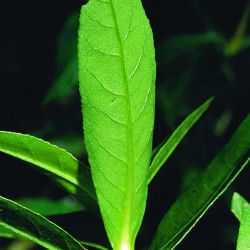Alligator weed

Alligator weed flower
© Queensland Government

Alligator weed ground cover
© Queensland Government

Alligator weed infestation
© Queensland Government

Alligator weed leaf
© Queensland Government

Alligator weed plant form
© Queensland Government

Alligator weed with biological control damage
© Queensland Government
Native to South America, alligator weed is a perennial plant that grows on land in damp soil, or on water as dense floating mats. Alligator weed affects water flow, water quality, native plants and native animals, and has major economic and social impacts.
Alligator weed poses an extreme threat to waterways, wetlands and irrigated crop lands from Cape York to Queensland's southern border.
Scientific name
Similar species
- Water primrose, smartweed
Description
- This vigorous perennial weed grows both in water and on land.
- Stems are hollow.
- Leaves are dark green with a distinct midrib, 2–12cm long, 0.5–4cm wide, and arranged in opposite pairs along the stem.
- There is no leaf stalk.
- Flowers are white, paper-like and ball-shaped. They are on short stalks 2–7cm long.
3D Model
- View the 3D model to help you identify this plant. You can magnify the image and manipulate the view to inspect the plant from every angle.
Habitat
- Optimum growth occurs in fresh water with a high nutrient level.
- Can tolerate brackish water.
- Can establish in semi-aquatic areas, in wetlands, on stream and creek banks, and on land.
Distribution
- Visit Weeds Australia to view a distribution map (select the distribution tab).
Life cycle
- Forms new shoots in spring from nodes on existing stems.
- Does not produce viable seed.
- Regrows quickly from stems or underground rhizomes.
- Flowers around midsummer.
Impacts
Environmental
- Poses an extreme threat to waterways and wetlands.
- Restricts water flow in creeks, channels and drains.
- Reduces water quality.
- Reduces water bird and fish activity.
- Kills fish and submerged native water plants.
- Replaces native wetland plants.
Economic
- Damages pumps and irrigation equipment.
- Poses an extreme threat to irrigated croplands.
- Increases water loss through evapotranspiration.
Social
- Impedes water sports and boating access.
- Endangers swimmers.
- Creates favourable habitat for mosquitoes.
How it is spread
- In water, stems break and float away to form new mats.
- Cuttings in soil or on equipment are spread when these are moved.
Prevention
Control
Mechanical control
- Successful mechanical removal of alligator weed is extremely difficult because the plant can re-establish from very small pieces.
- If care is not taken during mechanical control, spread is likely to occur by 2 methods:
- re-establishment from stem fragments
- spillage in transit or at dump sites.
Herbicide control
- Alligator weed grows in different situations, each requiring particular herbicide controls.
- Read the alligator weed fact sheet for herbicide control and application rates.
Biological control
Three biological control agents from South America have been introduced into New South Wales. Two of these insects are established and contribute to control of alligator weed growing in water but not on land:
- flea beetle (Agasicles hygrophila)
- stem-boring moth (Arcola malloi).
Legal requirements
- Alligator weed is a category 3 restricted invasive plant under the Biosecurity Act 2014. You must not:
- give it away
- sell it
- release it into the environment.
- You must take all reasonable and practical measures that are under your control to minimise the biosecurity risks associated with dealing with alligator weed. This is part of your general biosecurity obligation.
- Each local government agency must have a biosecurity plan that covers invasive plants in its area. This plan may include actions to be taken on alligator weed. Some of these actions may be required under local laws. Contact your local government for more information.
Further information
- Contact us online, by phone or in person.
- Read the alligator weed fact sheet.
- Read the alligator weed risk assessment (PDF, 554KB).
- View the alligator weed 3D model.
- Read Weeds Australia’s alligator weed profile.